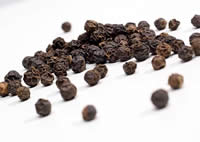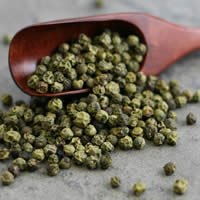Difference between Black Peppercorn and Green Peppercorn
Key Difference: Black pepper is the most commonly used peppercorn, which is grinded and used as a spice or seasoning in many cuisines. Black pepper is produced by being harvested when they are still green unripe drupes of the pepper plant. Green pepper, similar to black is made from unripe pepper drupes. They are not boiled but are dried and treated with sulfur dioxide, canning or freeze-drying, in order to retain the green color.
Peppercorns are fruits of a flower-bearing vine from the Piperaceae family, which are harvested and dried in order to be used as a spice and seasoning, along with salt. Peppercorns originate in tropical regions such as India, Vietnam and Indonesia, though are now being produced in other South Asian countries as well. Originally, peppers were used as currency in India and were expensive to purchase. There are various different kinds of peppercorn, which are distinguished by their color; black, green, white orange/red and pink.
 Black pepper is the most commonly used peppercorn, which is grinded and used as a spice or seasoning in many cuisines. Black pepper is produced by being harvested when they are still green unripe drupes of the pepper plant. The drupes are then boiled in hot water for a brief period and are dried under the sun. The heat in the water ruptures cell walls in the pepper, releasing browning enzymes during drying, causing the pepper to assume the dark color and wrinkle. The dried peppercorn can be crushed in order to extract oil or crushed in order to add to food as seasonings. Black pepper oil is used in as ayurvedic massage oil and is added to certain beauty and herbal treatments.
Black pepper is the most commonly used peppercorn, which is grinded and used as a spice or seasoning in many cuisines. Black pepper is produced by being harvested when they are still green unripe drupes of the pepper plant. The drupes are then boiled in hot water for a brief period and are dried under the sun. The heat in the water ruptures cell walls in the pepper, releasing browning enzymes during drying, causing the pepper to assume the dark color and wrinkle. The dried peppercorn can be crushed in order to extract oil or crushed in order to add to food as seasonings. Black pepper oil is used in as ayurvedic massage oil and is added to certain beauty and herbal treatments.

Green pepper, similar to black is made from unripe pepper drupes. They are not boiled but are dried and treated with methods such as sulfur dioxide, canning or freeze-drying, in order to retain the green color. Green peppercorns are mostly persevered in brine or vinegar and used as pickled pepper. This pepper is used in Asian cuisines, most commonly Thai dishes. It is described to have a piquant and fresh flavor with a bright aroma. Green pickles can decay quickly if it is not dried or preserved.
White peppercorn is the seed of the pepper plant, which is soaked in water for about a week in order to remove the dark colored skin of the seed, causing it to turn white. Ground white pepper is most commonly used in Chinese cuisines. Orange or red peppercorn usually consists of ripe red pepper drupes which are preserved in brine and vinegar. They are also treated with similar techniques as the green peppercorn in order to retain their color. Pink peppercorn does not come from the same plant as the other peppercorn, this particular peppercorn originates from the Peruvian pepper tree (Schinus molle) or the Brazilian pepper tree (Schinus terebinthifolius).
Peppercorns, not only enhance and enrich the flavor of dishes, they also offer health benefits. Peppercorns are high in minerals such as potassium, calcium, zinc, manganese, iron, magnesium, vitamin K, fiber and copper. They are also used in various cultures to improve the digestive tract. However, a high amount of peppercorns can cause gastrointestinal irritation, so it should be used moderately.
|
|
Black Peppercorn |
Green Peppercorn |
|
Definition |
Black pepper is a flowering vine in the Piperaceae family, which is usually dried and used as a spice in cuisine. |
Green pepper is similar to black pepper though it is made from a different process. |
|
Process |
Black pepper is picked in its unripe stage, boiled in hot water and then dried under the sun causing its skin to turn black and wrinkle |
Green pepper is picked when it is unripe, but is treated (with sulfur dioxide, canning or freeze-drying) in order to maintain its green color |
|
Origin |
India 2 BCE |
India 2 BCE |
|
Kingdom |
Plantae |
Plantae |
|
Family |
Piperaceae |
Piperaceae |
|
Binomial name |
Piper nigrum |
Piper nigrum |
|
Uses |
Cooking, medical uses, currency |
Cooking |
|
Cuisine |
Used in almost all types of cuisine |
French, Thai, and Western European |
|
Benefits |
High in potassium, calcium, zinc, manganese, iron, and magnesium, vitamin K, fiber and copper |
Improves digestive tract, reduces gas, increases hydrochloric acid, helps reduce several types of stomach distress, fight bacterial growth and high in iron, vitamin K, and antioxidants |
|
Cautions |
Excessive amounts of black pepper can cause gastrointestinal irritation, and bleeding from the ulcer sites |
Green peppers are perishable and can spoil quickly. Excessive green pepper can cause gastrointestinal irritation |
Image Courtesy: gayatriorganic.com, silkroadspices.ca









Add new comment